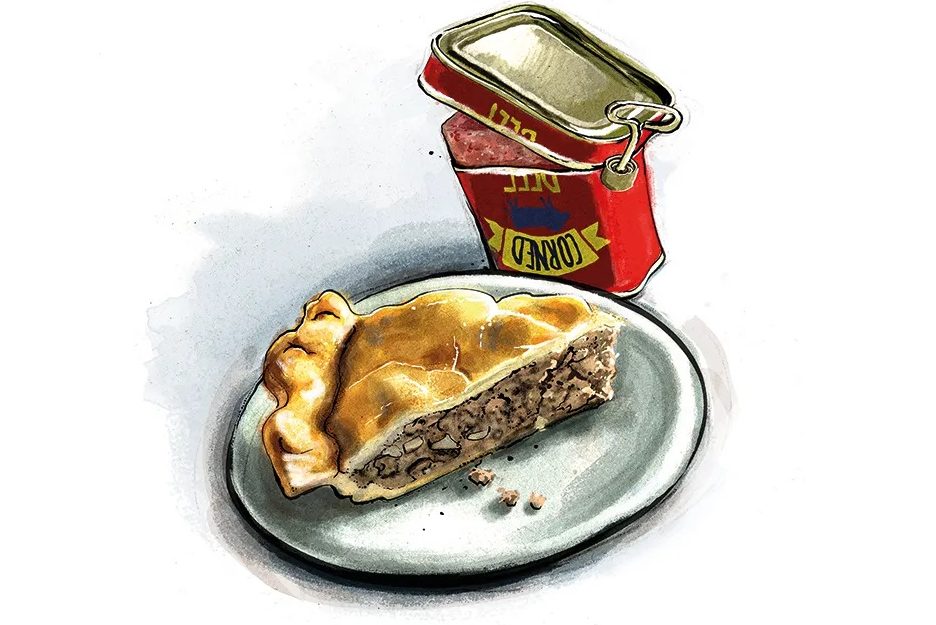A few weeks ago I was at the supermarket juggling a toddler, several heavy bags and, it transpired, no coin to insert into a shopping cart. A kind employee came to my rescue: on her key ring was one of those little keys you use to open tins of corned beef, which she deftly inserted and released, and lo, the cart was mine.
What a nifty trick! I immediately resolved to add one to my own key ring, and then almost as quickly forgot. But also, what a peculiar thing: we’ve very much accepted ring pulls, or even just using can openers, as the standard way to open cans. As a system it works very well. It’s pretty much only corned beef and spam that we still open with little keys that are precariously attached to the side of the can, slipping them on to the metal tab and turning them round and round, as if winding up a musical box, until a disconcertingly oblong-shaped slab of meat is revealed.
It was glorious, everything I wanted from a pie — an almost complete meal inside a golden crust
It feels like a real relic from the past — but then so too are the contents of the can. Corned beef has very much fallen out of fashion. Not to be confused with the cured salt beef of Jewish-American delis, known by the same name, the cured and canned corned beef — often called “bully beef” in Britain — came along with the Industrial Revolution. Much of it was made in Ireland and then exported; for a long time, it was a necessity, used as rations in the Boer and both world wars, thanks to its almost indefinite shelf-life. Today, we have refrigeration, stronger supply chains and therefore less need for meat preservation.
But I still have a real soft spot for corned beef. When my sister and I had ham-and-cheese toasties on a Sunday night, my parents always had corned beef and onion toasted sandwiches, so for a long time I associated corned beef with grown-up sophistication. Pan-fried corned beef hash, with a puddle of brown sauce, is a true comfort food, and sometimes I think I am single-handedly holding up the sliced corned beef market for the ultimate treat of a corned beef sandwich served in thickly buttered white bread with a good squirt of salad cream.
But it’s my stepmother’s corned beef and potato pie, which she nonchalantly served up to us one lunchtime, which has stolen my heart. It’s no exaggeration to say that I became a bit obsessed with the pie; I pestered her for the recipe, which was so simple as to verge on the vague. The quantities were elastic, the method informal. But that was the way she had always made it — the way it had always been made. So eventually, I swallowed my recipe dependence and just gave it a go. As I stirred the corned beef and sliced onion into mashed potato, worrying pointlessly about quantities, I couldn’t see how these elements could possibly come together into something more than the sum of their parts. I was wrong: it was glorious, everything I wanted from a pie — an almost complete meal inside a golden crust.
It’s a robust pie — you could probably cause some serious damage with it if you were so minded, although I’d recommend eating it instead — but that is part of its charm. The heft of the filling means that there’s no need to blind bake, or refrigerate the pastry for hours; it can all go straight into the oven once rolled and assembled. It also means that the pie slices beautifully cleanly, and is excellent later rewarmed or eaten cold. This makes it a particularly good candidate for lunch boxes and picnics.
The recipe is formalized here, for the sake of cookery-column propriety, but please know that this is a pie which lends itself to flexibility and approximation. My step-mother served it with a large bowl of coleslaw; my husband likes it with buttered, leafy greens — but as long as there’s a bottle of salad cream, I’m happy.
Serves 6
Bakes 35 minutes
Takes 40 minutes, plus chilling time
For the pastry
– 10 oz plain flour
– 1 teaspoon salt
– ½ lb cold butter, cubed
– 2 oz cold water
– 1 egg, to glaze
For the filling
– ¾ lb of corned beef
– 1½ lb potatoes
– 1 large onion, sliced
– 1 tbsp Worcestershire sauce
– ½ tsp white pepper
– Vegetable oil
- First make the pastry. Stir the salt through the flour, then rub the butter into the flour until it resembles breadcrumbs. Add the water little by little until the pastry comes together into a ball; you may not need all the water. Wrap in plastic wrap and refrigerate for half an hour
- Peel and chop the potatoes into chunks. Place in a large pan of cold water, bring to the boil and cook until tender. Drain, and mash the potato. Season with the salt and white pepper
- Sauté the onion in the vegetable oil until softened but not colored
- Break the corned beef into chunks and combine with the mashed potato and onion
- Using a pie dish approximately ten inches wide, take two-thirds of the pastry and roll it out into a rough circle a little bigger than your pie plate. Roll it up on to the rolling pin and use the rolling pin to lay it across the pie dish, easing it into the curves and crevices
- Spoon the filling into the pastry and use the back of a spoon to level it out. Roll out the remaining pastry into a circle and place on top as a lid
- Crimp the edges of the pastry together using the back of a fork, trimming away any excess pastry from the edge. Brush the top with beaten egg. Make a couple of holes in the top to let steam out
- Bake for 30-35 minutes until golden brown. Leave to rest for 15-20 minutes before slicing
To sign up for Olivia Potts’s bimonthly newsletter, which brings together the best of The Spectator’s food and drink writing, go to https://www.spectator.co.uk/food-newsletter/
This article was originally published in The Spectator’s UK magazine. Subscribe to the World edition here.


















